Make a Stitching Template for Precision Sewing
Leave guesswork behind with easy-to-make guides
Precision is something we sewers strive for, but occasionally we need a little help to achieve it. There is a tool you can make at home that ensures your stitching lines are straight, angled, or curved in just the right shape.
I make stitching templates from basic file folders; you can also use oaktag or heavy card stock. These inexpensive, easy-to-make stitching guides can be customized to any seam shape you require. There’s no need to mark lines on delicate or textured fabrics, and the templates stabilize the work as you stitch along them.
The same type of template works as a pressing guide, for straight, curved, or complex edge shapes. When a template gets a little worn around the edges, simply cut a new one.
Straight stitching
Templates help you place each stitching line where it belongs, without drawing lots of lines on the fabric.
Darts and pleats
Transfer the darts with a marker or tailor’s tacks, then fold on the foldline. Align the template along the dots, and place the work on the machine. Turn the handwheel to lower the needle next to the template. Lower the presser foot and start sewing, holding the template in place with your left hand. Stitch with the needle running alongside the template. This method helps to keep the off-grain dart seam under control as you sew.
The same process works for stitching pleats. Transfer the dots, fold the fabric, then stitch along a straight template. Refold and repeat for subsequent pleats.
Parallel topstitching
If your project calls for parallel topstitching rows that are more widely spaced than a presser foot or a quilting guide, use a template. Cut a long strip the width of the desired interval between stitching lines. Lay the template on the fabric, position the needle at its right edge, lower the presser foot to anchor the template, and sew along its right edge for the first stitching line. Shift the fabric to the left, align the template’s left edge on the stitched line, and again stitch along its right edge. Repeat across the project. The result is more accurate than drawing many lines on the fabric, and it guarantees you won’t have visible marks on the finished project.
Curved stitching
Templates make it easier to sew curved seamlines in the right shape and, more importantly, to keep them symmetrical on both sides of a garment.
Fly zipper topstitching

For accurate stitching, start by tracing the fly shape from the pattern between the opening edge and the topstitching line onto a file folder, and cut the template. Place a few pieces of double-sided tape on the template’s underside and adhere the template to the pants front. Be careful to avoid placing it on the zipper’s bottom stop. Topstitch along the template’s curved edge. I prefer to start at the bottom end of the zipper, to get past the stop first.
Collar stands and collars

Create a template that follows the collar stand’s seamline exactly. The template can be just the curved end plus a few inches beyond. Apply removable double-sided tape to the template’s back. Then place the template on the collar stand, with its curved edge along the seamline.
Stitch along the template’s edge, from center front toward center back; when you reach the template’s end, continue stitching at the required seam allowance width. When you’re nearing the other end of the collar stand, flip the template, move the sticky tape to the other side, position the template, and continue stitching to the end. The same type of template works for curved collar ends, too.
Curved Pocket Corners

A lined patch pocket with rounded corners demands the same perfect line of stitching as does a collar. Draw the finished corner shape (this is the pocket pattern’s seamline) and make a template. You can make a single corner template and flip it, as for a collar, or create a template for the entire pocket.
Shaped Darts
When you need two curved darts to be identical, as on the front of a sheath dress, a stitching guide ensures symmetry. Transfer the dart’s shape from the pattern to a file folder and cut it out. You need only one half of the dart, so split it vertically and cut along the center. Transfer any dart dots to the fabric, and fold the fabric along the dart’s center. Align the template’s straight edge with the dart fold and any dots you have marked. Use removable double-sided tape to secure it for stitching. Sew along the curved edge. Flip the template, stick it to the opposite dart, and sew.
Pressing
Get crisp, accurate folds by pressing over a firm but flexible template.
Narrow hems

You can use a straight template to press up a curved narrow hem. Mark the hem allowance depth on the template, and place the template on the fabric. Working a couple of inches at a time, hold the template firmly in place and press the fabric edge up to meet the marked hem depth on the template. Shift the template along and continue pressing.
Pocket corners

On an unlined pocket, place the corner template against the wrong side, aligned on the stitching line. With the iron’s tip, press up the seam allowance.
For a lined pocket, make a full template for the pocket, by tracing its finished edge onto a folder. Insert the template inside the pocket through the turning opening. With the pocket right side up, push the template into the rounded corners, keeping the seam allowances under the template. Press.
Seam allowances

To avoid creating impressions on the fabric’s right side, slide a strip cut from a folder between the garment and seam allowances as you press the allowances open. Do the same when pressing a dart to one side.
Tip
Save your templates. Once you’ve created a shaped template for a particular pattern, store it with the pattern for future use.
Irene Mischkinis is a sewing expert and teacher based in London, Ontario, Canada, and has worked as a custom clothier.

































What is best to create the templates from? Poster board, lightweight cardboard, heavy cardstock, etc? Thank you in advance for your time and help.